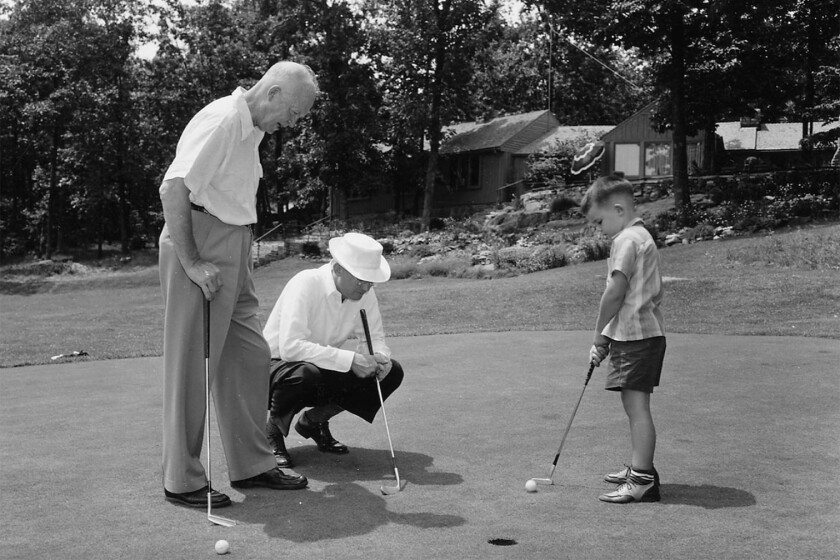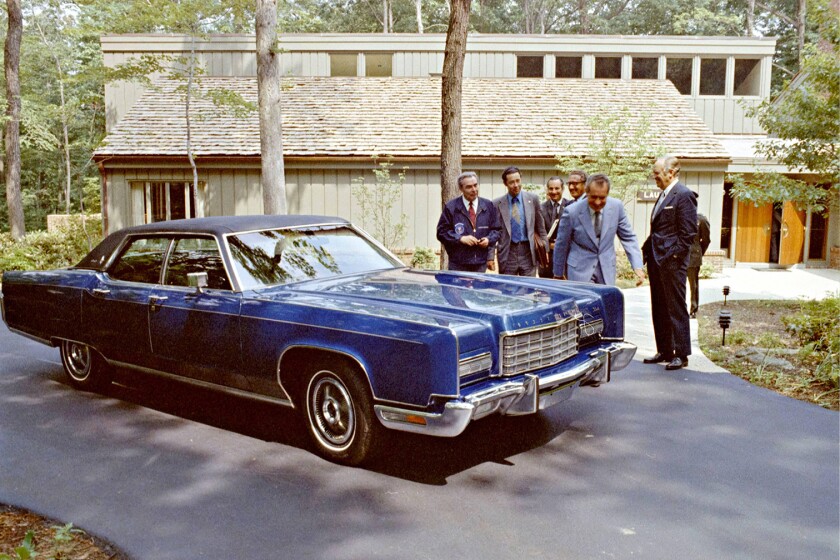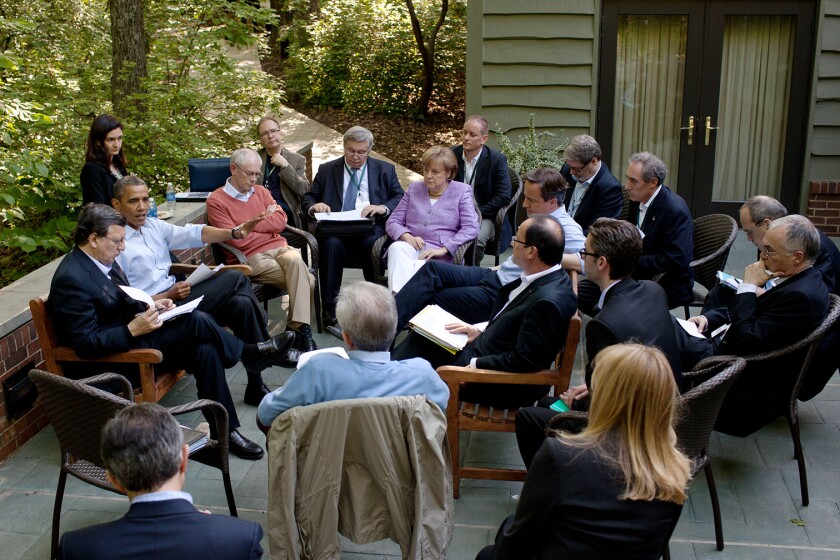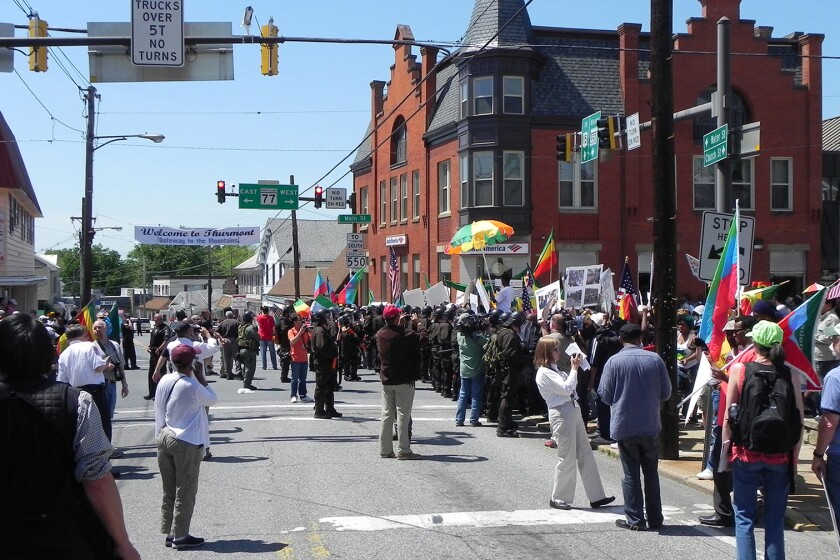
To their astonishment, they could clearly see President Franklin Roosevelt and British Prime Minister Winston Churchill sitting side-by-side in the rear of the car, waiting for the light to change. “Roosevelt had a hat on,” says Anne. “And he had a dog in his lap.” With arms outstretched, Churchill flashed a “V” sign to the few surprised onlookers. Soon enough, the light turned green, and the limousine made a left, heading six miles west to Shangri-La, the presidents retreat in the heavily wooded mountains of Maryland.
From the Water to the Woods
Sixty-five miles north of the White House, Roosevelt’s Civilian Conservation Corps (CCC) had constructed in 1938 a recreation area at the top of Catoctin Mountain above Thurmont. Intended for use by employees of the federal government and their families, the facility consisted of six oak cabins connected by dirt paths, a dining hall and swimming pool. Roosevelt visited the site in the spring of 1942 and loved it. Plumbing was installed, fences erected, and communications equipment brought in before he returned to the property on July 5.
The camp’s accommodations were comfortable but rustic (it was unused in the winter months, as there was no heat). Roosevelt named his hideaway Shangri-La, after the mystical place described in Lost Horizon, a favorite novel of the president.

(FDR Presidential Library and Museum)
Home Improvements
But he was ultimately persuaded to keep it. Thinking Shangri-La “just a little fancy for a Kansas farm boy,” he changed the name to Camp David, in honor of his grandson. Ike oversaw extensive improvements to the facility, remodeling and redecorating cabins, building a bomb shelter and a par-three, one-hole golf course. When President Kennedy took office, he was encouraged to change the name back to Shangri-La, but he declined to do so.

(Eisenhower Presidential Library)
The President’s Nearest Neighbor
Situated 10 miles south of Pennsylvania’s southern border, there are 7,000 citizens in the town of Thurmont, five times more than when Roosevelt was in residence at his mountain retreat. One weekend a year, the population swells to 125,000 when the annual arts and crafts festival takes place. Billing itself as “Gateway to the Mountains,” tourism drives a big part of the local economy. “We have branded ourselves as the place to come for outdoor activities,” says Vickie Grinder, the town’s economic development manager. “The parks bring people that buy gas; they eat at our restaurants. They keep a lot of our businesses in business.”
Mayor John Kinnaird is sure that proximity to the president is a plus for Thurmont. “Camp David brings a lot of attention to our community,” he says. “I think it’s a feather in our cap that the president thinks enough of this area that they have their getaway up here.”
As enthusiastic as he is about it, Kinnaird has never been inside the gates of the presidential retreat. His predecessor however, spent more than three years at the top of the mountain, stationed there as a Marine during the Reagan and Bush administrations.
Three-term former mayor Marty Burns is quick to recount his experience in service to two presidents. “When the Reagans were up there, they kind of kept to themselves,” he says. “The Bushes were completely different. You would never know that they were president and first lady. Barbara Bush would walk up and say, ‘Hey Marine, where are you from?’”

(Jimmy Carter Library)
Touching Down in Town
More often than not, when the president travels to Camp David today, it’s aboard a helicopter, landing within the compound. In 1957, Eisenhower was the first president to arrive by air, reducing the two-hour trip to just 30 minutes. In those early years, landing would take place on a local little league field or in front of the high school. More than one president has set down on a local golf course for a quick round of play. Landings today are made within the compound.
Jerry Brown has lived most of his 80 years in Thurmont. “A lot of times in the early days, the president would come up and the helicopter would land out on the other end of town,” he says. “There were people lining the streets. They wanted to see him going by. I know I went out and watched him get off the helicopter once or twice. I don’t remember which one. That’s been a good while ago.” But not every trip to Camp David is made by helicopter.
Presidential Road Trips
Back when he was a teenager, Paul Fedak was fishing one day at his family’s pond, not far from the road. A long line of black limousines, SUVs and police cars appeared through the trees, heading toward him as the procession wound its way down the hill. The motorcade slowed to a stop alongside the young man, and a heavily-tinted back window slowly lowered. “Hey,” came the voice of George H.W. Bush. “Are you catching anything?”
Truman and Kennedy would sometimes do their own driving at Camp David. On one occasion, JFK got behind the wheel of a new blue convertible and drove his family and some friends to nearby Gettysburg where they toured the battlefield. A helicopter took them back to the presidential compound.

(Nixon Presidential Library)
Local Sightings
Over the years, presidents and members of their families would make occasional trips into town. Many remember Laura Bush shopping at a local fabric store. Members of the president’s entourage and members of the military are routinely spotted around town. “We do see some soldiers in uniform in the stores,” says longtime resident Marian Harper. “You just start ignoring it.”
Mayor Kinnaird remembers an encounter at a sweet shop in the early 60s. “We were in there one afternoon and a babysitter came in with the two Kennedy kids,” he says. “They got ice cream and sat in the booth next to us. There was Secret Service with them. That was the impressive part. We didn’t give a crap who the kids were.”

(David Kidd/Governing)
The Unofficial Center of Town
It was a Sunday afternoon when Anne Prendergast caught sight of Winston Churchill and Franklin Roosevelt as they stopped for the traffic light in Thurmont. The world leaders had just departed the Cozy Cap Tavern, a local watering hole. According to the proprietor, Churchill enjoyed a beer while dropping nickels into the jukebox, leaving the president and his dog to wait in the car.
Until it was torn down six years ago, Thurmont’s Cozy Country Inn and Restaurant was the unofficial center of town life. The establishment opened in 1929 as a small collection of tents, cabins and showers to accommodate the increasing numbers of tourists traveling by automobile. A gas station, restaurant and hotel were added over the years. The latter featuring rooms named after presidents and news outlets. Other than Roosevelt, no president is known to have visited.
Press and Protests
Taking advantage of the privacy and security available at Camp David, presidents have used the facility for high-level diplomacy and meetings between heads of state. Jimmy Carter famously brokered the Camp David Accords between Egypt and Israel in 1978. More recently, Barack Obama hosted a meeting of the G8 there in 2009. “The Camp David Accords was a big deal here in Thurmont.,” says longtime resident Jerry Brown. “Of course, we were used to Camp David. But that was something bigger, with all the press and so on.”

(Official White House Photo by Pete Souza)
“When the world press shows up, they’re everywhere,” says Mayor Kinnaird. “When they had the G8 summit, we had camera crews everywhere. They were just looking for people to talk to. Anything that would say something, they interviewed it.”
Not only does the influx of media strain the town’s resources, so too do the hordes of protestors that can accompany the president and other world leaders. Prohibited from protesting anywhere near Camp David, protestors are relegated to making their views heard in Thurmont.

(Wiki Commons)
Quiet on the Mountain
A lot of the locals think Donald Trump didn’t spend any time there since he had other options more to his liking. But the record shows that he visited 14 times during his four years in office, none of them apparently newsworthy. Joe Biden has made at least ten visits since he took office, and the townspeople barely take notice. “I think most of the people in town today just take it for granted,” says 80-year-old Jerry Brown. “It’s been there for so long. Now the newcomers, the people that have just moved here in the last 10 years, they might find it more interesting than the older folks."
An Accidental Tourist
Anne Prendergast never saw President Roosevelt again after the surprise sighting from her front porch. But she did manage to get close to the presidential compound, also by chance. A year or two later, a favorite uncle bought her a brand-new Schwinn bicycle. “It had everything,” she says. “A horn, a light and a basket. Just a beautiful bike.” Anne and a friend decided they would try to ride up the mountain one day. “Well, we rode most of the way,” she says. “Much of it we had to push the bikes, because it was so steep.”
“We decided when we got up there, we were going to turn around and just go flying down the mountain,” Anne says. “And all of a sudden, two Marines with rifles came out of nowhere, and made us stop and wanted to know who we were and where we were going. It scared the living daylights out of us. They told us get on our bikes and go back to Thurmont. Which we promptly did.”
Related Articles












